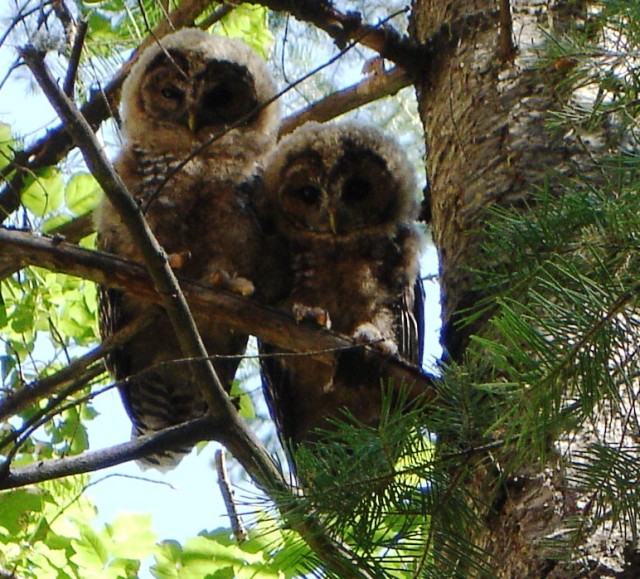Species flourishing is feather in Lab cap
For the first time since the Cerro Grande Fire, Laboratory ecologists have spotted three Mexican Spotted Owl chicks on Laboratory property. The Mexican spotted owl (Strix occidentalis lucida) was listed as a threatened species in 1993.
The Laboratory has been monitoring Mexican Spotted Owl nesting locations since 1994. In 2000, Laboratory officials worried that the 44,000-acre Cerro Grande Fire would devastate the owl population. But while the fire may have destroyed the nests that year, the fire may have been beneficial overall to the owl populations by creating more diverse and complex forests.
Laboratory officials see the population increase as a real success, according to staff ecologist Dave Keller of Ecology (ENV-ECO). Many precautions are taken during the nesting season so that the owl families go undisturbed. Restrictions are in place in the spring, mostly reducing noise and activities in suspected nesting locations. In some instances, Laboratory workers use hand tools instead of power tools to ensure the success of the owl population.
The Laboratory is the only location east of the Valles Caldera in the Jemez Mountains where the owls have been reported to successfully produce chicks. Much of the forest behind the fence, where the general public is prohibited, is a perfect habitat for the species to flourish.
“The observations of not just two, but three chicks this year indicates that their habitat is being protected from noise and activities during the critical times of the year allowing the species to successfully reproduce,” Keller said.
The Mexican Spotted Owl is one of three subspecies of spotted owl — Mexican, California and Northern. This strictly nocturnal bird is fairly large, between 16 to 21 inches tall. It is dark brown with a puffy head and has white spots on its head, back, and chest and barred underparts. Unlike most other owls, the Mexican Spotted Owl is dark-eyed rather than yellow-eyed.
The Mexican Spotted Owl prefers old-growth forests in canyons and moist areas for breeding. Spotted owls nest and roost primarily in closed-canopy forests or rocky canyons. They nest in these areas on cliff ledges, in stick nests built by other birds, on debris platforms in trees, and in tree cavities. In southern Utah, Colorado, and some portions of Northern New Mexico, most nests are in caves or on cliff ledges in rocky canyons. Forests used for roosting and nesting often contain mature or old-growth stands with complex structure, are typically uneven-aged, multistoried and have high canopy closure.
It will forage for woodrats and mice in forests, woodlands and rocky areas. The owls prey on a variety of species, including woodrats, mice, voles, rabbits, gophers, bats, birds and reptiles. They are considered to be "perch and pounce" predators because they locate prey from an elevated perch by sight or sound, then pounce on the prey to capture it.
Males and females pair in March and eggs are laid in March or April. The female incubates the egg for 30 days. The young owls fledge – or acquire the necessary wings for flying – about four-to-five weeks after hatching. Even before flying, owlets often leave their nest by jumping onto tree branches or the ground. Three weeks after leaving the nest, the young can hold and tear prey on their own.
This subspecies of the spotted owl is found in northern Arizona, southeastern Utah and southwestern Colorado south through New Mexico, west Texas and into Mexico. The Mexican spotted owl generally inhabits mixed conifer, pine-oak and riparian habitat in mountains and canyons.


